No edit summary |
Kentsmith9 (talk | contribs) (Converted to single spacing after period to match the rest of the pages.) |
||
| (7 intermediate revisions by 2 users not shown) | |||
| Line 1: | Line 1: | ||
{{NeedImage}} | {{NeedImage}} | ||
This article reviews the most commonly misunderstood aspects of editing in the USA using the [[Waze Map Editor]] (WME). For those new to the WME it describes some of the mistakes that can result from these misunderstandings. | This article reviews the most commonly misunderstood aspects of editing in the USA using the [[Waze Map Editor]] (WME). For those new to the WME it describes some of the mistakes that can result from these misunderstandings. For advancing editors and Area Managers, it describes how best to respond when mistaken edits are discovered. {{:Edits to avoid/Do not panic}} | ||
{{TOC}} | {{TOC}} | ||
| Line 8: | Line 8: | ||
Waze created the WME with the desire to attract as many editors as possible. To this end, the WME allows anyone to change the map quickly and easily without reading, training, practice, or tests. | Waze created the WME with the desire to attract as many editors as possible. To this end, the WME allows anyone to change the map quickly and easily without reading, training, practice, or tests. | ||
Beneath the WME's welcoming exterior, however, lies cutting-edge technology. It provides expert tools that may behave differently depending on subtle—sometimes even invisible!—details. | Beneath the WME's welcoming exterior, however, lies cutting-edge technology. It provides expert tools that may behave differently depending on subtle—sometimes even invisible!—details. It offers little built-in documentation, and labels a few key features counterintuitively. Under some conditions, particularly involving turn angles, road type, and both primary and alternate street names, it can produce unexpected routing results and trip up experts and beginners alike. | ||
This situation guarantees that no editor will escape the WME unscathed. We all make mistakes, and lots of them. | This situation guarantees that no editor will escape the WME unscathed. We all make mistakes, and lots of them. Don't panic! You are in good company. | ||
This article discusses three categories of confusion: misunderstood principles, functional mistakes, and misunderstood conventions. Before discussing those, however, it's critical to bring up one kind of incorrect "edit" that is of greater concern than all the others put together. | This article discusses three categories of confusion: misunderstood principles, functional mistakes, and misunderstood conventions. Before discussing those, however, it's critical to bring up one kind of incorrect "edit" that is of greater concern than all the others put together. | ||
| Line 16: | Line 16: | ||
== {{Anchor|Worst|The worst incorrect edit}} The worst incorrect edit == | == {{Anchor|Worst|The worst incorrect edit}} The worst incorrect edit == | ||
{{Red|The worst incorrect edit of all is being unreachable by your fellow editors.}} | {{Red|The worst incorrect edit of all is being unreachable by your fellow editors.}} In the event that you appear unintentionally to be damaging the map, the editing community will try desperately to reach you to help you become a better editor. Or, if another editor needs to understand why you structured your edits the way you did, he or she may reach out to you before assuming they were in error and undoing them. If you cannot be reached, the editing community can only guess regarding your edits and has limited means to restrain further potential damage. | ||
'''{{Red|You must ensure that e-mails sent to the address you gave Waze will reach you quickly.}} | '''{{Red|You must ensure that e-mails sent to the address you gave Waze will reach you quickly.}} This means not only providing Waze with an email address you check regularly, but verifying that emails sent to that account from ''waze.com'', especially from ''forum@waze.com'', will pass any spam or junk-mail filters.''' | ||
If you receive an email indicating that you have a private message (PM), '''{{Red|please read the PM}}.''' | If you receive an email indicating that you have a private message (PM), '''{{Red|please read the PM}}.''' To do so from any Waze page, select SUPPORT, then "Community Forums", then near the top left of the screen, "new messages". You can also access your inbox directly [http://www.waze.com/forum/ucp.php?i=pm&folder=inbox using this link.] '''If the PM is from a fellow editor advising you of possibly incorrect edits, {{Red|please respond!}}''' | ||
Please note that simply ensuring one is visible on the [[Waze_Map_Editor/Chat|WME Chat system]] when actively editing isn't enough. | Please note that simply ensuring one is visible on the [[Waze_Map_Editor/Chat|WME Chat system]] when actively editing isn't enough. Getting an editor's attention via the Chat is not as reliable as via the Forum PM system and doing so requires much more effort. | ||
== Misunderstood principles == | == Misunderstood principles == | ||
| Line 30: | Line 30: | ||
=== Misunderstanding Waze's purpose === | === Misunderstanding Waze's purpose === | ||
'''Wrong:''' | '''Wrong:''' Waze is a general-purpose mapping application for whatever I would like to map, including my favorite walking trails, hidden creeks and ponds, historic but abandoned railroad right-of-ways, my bicycle shortcut through town, and my preferred parallel-parking spot. | ||
'''Right:''' | '''Right:''' '''Waze is NOT a general-purpose mapping application, a walking or bicycling tool, or a means to support strictly personal routes and destinations.''' It is designed specifically to assist drivers of motor vehicles to navigate to their objectives and to avoid traffic. Edits to the map that do not support these goals in some way are strongly discouraged. Edits that detract from these goals, even unintentionally, do not belong at all. | ||
=== The tragedy of deletion and disconnection === | === The tragedy of deletion and disconnection === | ||
'''Wrong:''' | '''Wrong:''' How I edit the Waze map makes no difference as long as it ends up looking right. | ||
'''Right:''' | '''Right:''' Each road segment contains accumulated traffic data from passing Wazers. Although you cannot see this data, it is essential for routing. This data reflects how long it took Wazers to pass through the segment and how long it took to turn at its end, for any given time of day and day of week. If a segment is deleted, all data is lost. If the segment is disconnected and reconnected elsewhere, the turn data is lost. Editors should strive to avoid deletion and disconnection wherever possible. | ||
=== Assuming road types are intuitively obvious | === Assuming road types are intuitively obvious === | ||
{{details|Road types}} | {{details|Road types}} | ||
'''Wrong:''' | '''Wrong:''' When deciding what type to apply to a road segment, I can rely on my intuitive conception of highways, ramps, streets, walking trails, et cetera. The fact that a road type is available in the Waze Map Editor means I should use it; Waze wants me to create anything they offer in that list, and to do so wherever I think it makes sense. For existing road segments, I am welcome to promote and demote them to whatever road type I think is appropriate. | ||
'''Right:''' | '''Right:''' Waze road types have specific meanings. Choice of road type can affect routing and voice instructions, sometimes in surprising ways. Many drivable routes have been typed carefully according to government data. Other travel paths, particularly driveways, access roads, and walking trails, are often deliberately left unmapped. Don't change existing road types until you understand their different properties, and be cautious when creating [[#Access_roads_that_distort_routing|access]] and [[#Unnecessary_and.2For_connected_Walking_Trails|non-drivable]] roads. | ||
=== Trying too hard to match the satellite image === | === Trying too hard to match the satellite image === | ||
'''Wrong:''' | '''Wrong:''' The Waze map should match the satellite image as closely as possible. | ||
'''Right:''' The Waze map should be as simple as possible while still providing accurate navigation and timely voice instructions for drivers of motor vehicles. | '''Right:''' The Waze map should be as simple as possible while still providing accurate navigation and timely voice instructions for drivers of motor vehicles. Often abstract or sparse representations, though they may look odd or wrong, will serve these goals best. In other situations it is better not to map a road at all. Clean maps and useful navigation must never be sacrificed for the sake of literal representation. | ||
[[File:TryingTooHard.png|thumb|left|300px|'''Trying too hard.''' | [[File:TryingTooHard.png|thumb|left|300px|'''Trying too hard.''' This emphasis on literal representation adds nothing to routing, and the resulting turn instructions may confuse drivers. Further, editors attempting to understand any routing issues in the area must cope with six times as many segments and junction nodes as necessary!]] | ||
[[File:TryingTooHard_fixed.jpg|thumb|right|300px|A single segment without at-grade connectors provides a clean, straightforward routing solution. | [[File:TryingTooHard_fixed.jpg|thumb|right|300px|A single segment without at-grade connectors provides a clean, straightforward routing solution. The median is not so wide it requires representation as a divided highway, and no other segments exist nearby that could snap the driver to the wrong road. Turn instructions will be simple, and the construction is much easier to analyze and maintain.]] | ||
{{clear}} | {{clear}} | ||
| Line 71: | Line 71: | ||
{{details|Creating and editing road segments}} | {{details|Creating and editing road segments}} | ||
'''Mistake:''' | '''Mistake:''' Roads that appear outlined in red in WME were published before all necessary parameters were set properly. Red roads created from the pave feature of the mobile app are useless for routing, while red roads created using WME are routable. In either case, their prominent display in the WME calls attention to incomplete edits. | ||
'''Response:''' | '''Response:''' Do not automatically delete red roads! The road may be red because a user added a missing road using the pave feature, or because a local editor with first-hand knowledge created it in the editor but did not [[Creating_and_editing_road_segments#Confirm_the_road_by_updating_details|confirm its details]]. These roads may reflect construction that occurred since the satellite and/or street-view imagery was acquired. | ||
If the red road appears to indicate a drivable road that will improve routing to adjacent destinations, complete it as necessary and verify turn restrictions. Try to preserve the creator's name out of respect for their having found the omission and attempting to remedy it. | If the red road appears to indicate a drivable road that will improve routing to adjacent destinations, complete it as necessary and verify turn restrictions. Try to preserve the creator's name out of respect for their having found the omission and attempting to remedy it. | ||
| Line 85: | Line 85: | ||
{{details|Roundabouts}} | {{details|Roundabouts}} | ||
'''Mistake:''' The [[Creating and Editing a roundabout|WME Roundabout tool]] creates an intersection that gives roundabout-specific routing instructions to drivers, such as "at the roundabout, take the third exit" (for roundabouts at complex intersections) or "turn left at the roundabout" (for roundabouts at simple perpendicular intersections). | '''Mistake:''' The [[Creating and Editing a roundabout|WME Roundabout tool]] creates an intersection that gives roundabout-specific routing instructions to drivers, such as "at the roundabout, take the third exit" (for roundabouts at complex intersections) or "turn left at the roundabout" (for roundabouts at simple perpendicular intersections). '''If those routing instructions could confuse drivers, the Roundabout tool should not be used.''' Roundabouts do not belong at cul-de-sacs or other dead ends, regardless of how round they are. Neither do they belong at traffic calming circles without roundabout signs, at decorative turns, or at circular entrance driveways. Depending on circumstances, they may be inappropriate for large traffic circles, especially those with street names of their own and stop signs or lights controlling access. | ||
'''Response:''' | '''Response:''' If the satellite image leaves doubt, use Street View to verify that no signs suggestive of a roundabout are present. If it is a roundabout, ensure the layout matches the desired roundabout routing behavior, either orthogonal or odd-angle. If it is not a roundabout, delete it and replace or repair any associated connections. | ||
[[File:Roundabout_wrong.png|thumb|300px|left|Improper use of the [[Creating and Editing a roundabout|Roundabout tool]].]] | [[File:Roundabout_wrong.png|thumb|300px|left|Improper use of the [[Creating and Editing a roundabout|Roundabout tool]].]] | ||
[[File:Roundabout_fixed.png|thumb|300px|right|Corrected using the Road tool.]] | [[File:Roundabout_fixed.png|thumb|300px|right|Corrected using the Road tool.]] | ||
| Line 93: | Line 93: | ||
=== Overlapping segments === | === Overlapping segments === | ||
'''Mistake:''' | '''Mistake:''' Except in the cases of at-grade connectors and railroads, there should be only one segment routing traffic along any given street. Overlapping segments wreak havoc with the routing and house-numbering systems. | ||
Sometimes editors create overlapping segments because they don't know how to modify the existing segment, or find it is locked above their editing rank. The correct approach is to seek help, not to add a new segment on top of an existing one. | Sometimes editors create overlapping segments because they don't know how to modify the existing segment, or find it is locked above their editing rank. The correct approach is to seek help, not to add a new segment on top of an existing one. | ||
'''Response:''' | '''Response:''' Identify the overlapping segment -- typically the one without house numbering and/or with improper connections to other nearby segments -- and delete it. Repair turn permissions. | ||
[[File:Overlapping.jpg|left|thumb|300px|'''Overlapping segments.''' | [[File:Overlapping.jpg|left|thumb|300px|'''Overlapping segments.''' The portion of Ewert Rd departing at extreme top left is closed to unauthorized motor vehicle traffic. An editor has tried to represent this with a one-way Private Road segment that splits from Ewert much too early and, as a result, overlaps an open two-way segment of Ewert Rd for over 100 meters. Waze will have no idea which of these segments a driver is on or how to assign segment speed data correctly.]] | ||
[[File:Overlapping_fixed.jpg|right|thumb|300px|The overlapping segment has been removed altogether, since it was only added to support authorized vehicles or non-motorized use. | [[File:Overlapping_fixed.jpg|right|thumb|300px|The overlapping segment has been removed altogether, since it was only added to support authorized vehicles or non-motorized use. Connecting such segments to the public road network is strongly discouraged.]] | ||
{{clear}} | {{clear}} | ||
=== Disconnected/disjoint segments === | === Disconnected/disjoint segments === | ||
'''Mistake:''' | '''Mistake:''' Just because segments appear to intersect doesn't mean they really do. A proper intersection will display all turn restrictions if any connecting segment is selected. A segment that only appears to connect will not only fail to route but will also confuse editors trying to understand the failure. | ||
'''Response:''' | '''Response:''' If the intersection appears valid and the segment is correct, routable, and complies with conventions, connect the segment and set turn restrictions appropriately. If the intersection is not valid but the segments are correct, space them so it will be obvious to other editors that they do not connect, and consider locking them to be sure they stay that way. Otherwise delete the segment. | ||
[[File:Disjoint_wrong.png|left|thumb|300px|'''A disconnected and disjoint segment.''' | [[File:Disjoint_wrong.png|left|thumb|300px|'''A disconnected and disjoint segment.''' The southeast segment appears to connect with the through road at reduced zoom, but when seen at higher magnification it obviously doesn't. The Waze routing algorithm will treat this segment as a dead end. Situations like this can be very hard to detect. This example apparently resulted from [[#Failed_editing_due_to_locked_segments|failed editing due to locked segments]].]] | ||
[[File:Disjoint_fixed.png|right|thumb|300px|The segment has been connected and aligned to give "stay left" or "stay right" instructions for drivers arriving from the north. | [[File:Disjoint_fixed.png|right|thumb|300px|The segment has been connected and aligned to give "stay left" or "stay right" instructions for drivers arriving from the north. Turn restrictions have been set to permit turns.]] | ||
{{clear}} | {{clear}} | ||
=== Failed editing due to locked segments === | === Failed editing due to locked segments === | ||
[[File:Failed_attach_undetectable.png|right|thumb|300px|'''A segment that failed to attach to a locked road.''' | [[File:Failed_attach_undetectable.png|right|thumb|300px|'''A segment that failed to attach to a locked road.''' A Rank-1 editor has created a new road, but could not attach it to Delaware Ave, locked at Rank 2. The editor instead simulated attachment so perfectly that the disconnection is undetectable even at the highest zoom. The new road is broken, but it may be a long time before anyone discovers it. (The new segment is also incorrectly named, spelling out the suffix instead of using the proper "Rd" abbreviation.)]] | ||
'''Mistake:''' | '''Mistake:''' It is impossible for entry-level editors to attach new segments to a road locked above their rank. If it is attempted, the result is [[#Disconnected/disjoint segments|disconnected/disjoint segments]] as described above. Worse, the new editor may assume that they did indeed correct the problem, and leave the area invisibly broken until someone else stumbles across it. | ||
'''Response:''' | '''Response:''' At the very least, move the end of the disconnected segment away from the failed attachment area so that it is visually obvious to other editors that the road does not connect. You will cause no harm by doing so, as the routing connection is already broken. You are only making an invisible problem visible, which helps everyone. | ||
Then, capture a [[Waze_Map_Editor#Permalink|permalink]] of the problem segment and contact an editor of the required rank to fix the connection. | Then, capture a [[Waze_Map_Editor#Permalink|permalink]] of the problem segment and contact an editor of the required rank to fix the connection. There are four typical ways to do this: | ||
*Broadcast a request for help in the [[Waze Map Editor/Chat|Waze Map Editor Chat]]. | *Broadcast a request for help in the [[Waze Map Editor/Chat|Waze Map Editor Chat]]. Be sure to specify the rank you need and the region involved. Not all editors monitor the chat, and of those that do, not all will have the necessary rank and editable area to help you. Before you call for help, adjust your editor view so that the problem segment lies in the middle of your window, as the helping editor may simply jump to your location via the chat-users list. Have the permalink handy to send if requested. | ||
*Submit an "unlock/update request" to the Community Forums. | *Submit an "unlock/update request" to the Community Forums. [http://www.waze.com/forum/viewtopic.php?t=51274%7C This post describes the general procedure] but is not country-specific. [http://www.waze.com/forum/viewtopic.php?t=46319%7C Many countries have their own unlock/update forums]; it's important to post in the correct one and use the correct protocol! Include the permalink in your post. | ||
*Send a Private Message (PM) via the forums to an active local editor of the necessary rank, such as an Area Manager or other local senior editor with whom you've established a connection. | *Send a Private Message (PM) via the forums to an active local editor of the necessary rank, such as an Area Manager or other local senior editor with whom you've established a connection. Include the permalink in your message. | ||
*Send a PM to the editor whose name is marked as having last modified the locked segment. | *Send a PM to the editor whose name is marked as having last modified the locked segment. This does not always work but is worth trying especially if the first three approaches don't seem to be getting you anywhere. Include the permalink in your message. | ||
[[File:Failed_attach_shown.png|left|thumb|300px|Using standard tools, the only way to tell that the new segment is disconnected is to select it. | [[File:Failed_attach_shown.png|left|thumb|300px|Using standard tools, the only way to tell that the new segment is disconnected is to select it. The selected segment lacks turn restrictions onto Delaware Ave, showing that it is a dead end.]] | ||
[[File:Failed_attach_fixed.png|right|thumb|300px|Once the segment is attached, turn restrictions now appear normal.]] | [[File:Failed_attach_fixed.png|right|thumb|300px|Once the segment is attached, turn restrictions now appear normal.]] | ||
| Line 134: | Line 134: | ||
=== Corrupted turn restrictions === | === Corrupted turn restrictions === | ||
'''Mistake:''' | '''Mistake:''' Sometimes when modifying an intersection an editor will, through accident or lack of awareness, leave important turn restrictions red. This will prevent routing on the affected segments. In the worst cases significant roads may effectively be closed to Wazers, who are instead detoured through adjacent neighborhoods. | ||
'''Response:''' | '''Response:''' Correct the turn restrictions as soon as possible. | ||
[[File:CorruptedTurn.png|left|thumb|300px|'''Corrupted turn restriction.''' | [[File:CorruptedTurn.png|left|thumb|300px|'''Corrupted turn restriction.''' An editor has modified the at-grade connector for right turns from the Laurel Street Bridge onto San Lorenzo Blvd but has unintentionally left a critical turn restriction red, creating a partial bridge closure. The closure will dramatically affect routing in the area, possibly forcing Wazers to another bridge to bypass the restriction.]] | ||
[[File:CorruptedTurn_fixed.png|right|thumb|300px|Turn restrictions for the at-grade connector as they should appear.]] | [[File:CorruptedTurn_fixed.png|right|thumb|300px|Turn restrictions for the at-grade connector as they should appear.]] | ||
| Line 147: | Line 147: | ||
{{details|Creating and editing road segments#Editing existing roads{{!}}Editing existing roads}} | {{details|Creating and editing road segments#Editing existing roads{{!}}Editing existing roads}} | ||
'''Mistake:''' | '''Mistake:''' Excess geometry nodes slow the display and make a segment harder to edit, while misaligned nodes affect display aesthetics and in extreme cases disrupt Waze's ability to determine what road a driver is on. | ||
'''Response:''' | '''Response:''' Remove excess geometry nodes (using mouse-hover and the 'd' key) and correct misaligned nodes. | ||
[[File:GeometryNodes_excessive.png|thumb|left|300px|'''Excessive use of geometry nodes.''' | [[File:GeometryNodes_excessive.png|thumb|left|300px|'''Excessive use of geometry nodes.''' This segment incorporates 13 geometry nodes. This is far more than necessary here and makes the segment harder to adjust.]] | ||
[[File:GeometryNodes_efficient.png|thumb|right|300px|Three geometry nodes provide sufficient detail for this segment.]] | [[File:GeometryNodes_efficient.png|thumb|right|300px|Three geometry nodes provide sufficient detail for this segment.]] | ||
{{clear}} | {{clear}} | ||
=== Misunderstanding the "Highway" road type === | === Misunderstanding the "Highway" road type === | ||
'''Mistake:''' | '''Mistake:''' It is counterintuitive, but in Waze, "highway" does not necessarily mean a road that carries a lot of traffic. It just means a road that carries more traffic than nearby alternatives. For example, a barely-maintained one-lane mountain road may be a "Minor Highway", and a two-lane street serving a small village a "Major Highway". Assessing a road by its significance relative to nearby alternatives is called "functional classification" or FC. | ||
Such situations often baffle new editors to whom this application of the word "highway" seems absurd. As a result, some will attempt to "put it right" by lowering Highways to Streets or Primary Streets, unwittingly ruining the careful and methodical work that was required to set the road type according to national FC standards. | Such situations often baffle new editors to whom this application of the word "highway" seems absurd. As a result, some will attempt to "put it right" by lowering Highways to Streets or Primary Streets, unwittingly ruining the careful and methodical work that was required to set the road type according to national FC standards. | ||
'''Response:''' | '''Response:''' Find the government FC map for the affected area and restore the Waze road classifications according to editing-community conventions. Consider locking the affected segments, especially if local convention recommends it. | ||
[[File:MisunderstoodHighway.png|left|thumb|300px|'''Misunderstood highway classification.''' | [[File:MisunderstoodHighway.png|left|thumb|300px|'''Misunderstood highway classification.''' An editor has dropped two segments of Elm St from Minor Highway to Primary Street, contrary to the local authority's functional classification. This change introduces a discontinuity of road type between Holly St, San Carlos Ave, and the southern portion of Elm St. The discontinuity will distort routing of through traffic.]] | ||
[[File:MisunderstoodHighway_fixed.png|right|thumb|300px|Elm St has been restored to match the local authority's functional classification for this area.]] | [[File:MisunderstoodHighway_fixed.png|right|thumb|300px|Elm St has been restored to match the local authority's functional classification for this area.]] | ||
| Line 168: | Line 168: | ||
=== Unnecessary representation by divided one-way segments === | === Unnecessary representation by divided one-way segments === | ||
'''Mistake:''' | '''Mistake:''' Just because a road is divided by a median strip in reality is not enough reason to represent it as divided in Waze! Dividing roads on the Waze map can cause much trouble and should not be attempted without care. Always check with the local Area Manager before dividing a road and follow [[Best_map_editing_practice#When_to_Split_a_Two-Way_Road_.28and_when_not_to.29|best map-editing practice]]. | ||
'''Response:''' | '''Response:''' Check with the local Area Manager or a Champ. Restoring roads to undivided status can cause as many headaches as dividing them in the first place. Do not automatically assume that a newly-divided road is incorrect, even if the road appears to have been divided poorly or by a novice editor. | ||
[[File:Unnecessary_split.png|thumb|left|300px|'''Unnecessary road division.''' | [[File:Unnecessary_split.png|thumb|left|300px|'''Unnecessary road division.''' Dividing this road accommodated a median that is present over a short distance, but was unnecessary for routing to adjacent destinations.]] | ||
[[File:Unnecessary_split_fixed.png|thumb|right|300px|An undivided road serves this area well as long as turn restrictions are set properly, and it is easier to inspect and maintain.]] | [[File:Unnecessary_split_fixed.png|thumb|right|300px|An undivided road serves this area well as long as turn restrictions are set properly, and it is easier to inspect and maintain.]] | ||
{{clear}} | {{clear}} | ||
| Line 177: | Line 177: | ||
=== Walking Trails === | === Walking Trails === | ||
[[File:WalkingTrailsParallel.png|thumb|right|350px|'''Potentially harmful Walking Trails.''' | [[File:WalkingTrailsParallel.png|thumb|right|350px|'''Potentially harmful Walking Trails.''' Many of these trails are closely parallel to drivable roads. The slightest GPS error may snap drivers to the trails instead of the roads. Meanwhile, the trails will only poorly protect the roads from the false speed data of cyclists misusing Waze, because the cyclists may just as easily be snapped to the roads instead of the trails. Several drivable destinations are in the area, routing to which may be corrupted as a result of the trails. These trails add unnecessary complexity, encourage improper use of Waze by cyclists thus increasing the risk of speed-data pollution, put driving Wazers at risk of bad routes, and offer a poor example to other editors looking for ways to contribute. They should be removed.]] | ||
{{details|pedestrian path|the walking trail/pedestrian path road types}} | {{details|pedestrian path|the walking trail/pedestrian path road types}} | ||
'''Mistake:''' | '''Mistake:''' Because WME offers a "Walking Trail" road type, it may seem that Waze wants editors to map pedestrian and cycling paths in addition to normal roads for motor vehicles. This is not correct! Few circumstances call for mapping Walking Trails. They should be very rare and mapped by experts only. | ||
{{NeedInfo|This information may need review as of WME v2.9-48.}} | {{NeedInfo|This information may need review as of WME v2.9-48.}} | ||
*Walking Trails are fully routable and can affect routing even when disconnected! | *Walking Trails are fully routable and can affect routing even when disconnected! '''Connected or not, the Walking Trail type should never be used where effects on local routing are not desired.''' | ||
*The use of Waze while walking or cycling can damage Waze's speed and traffic database. | *The use of Waze while walking or cycling can damage Waze's speed and traffic database. Such uses should be discouraged. '''Editors should not map Walking Trails, or any other road type, for the sole purpose of encouraging non-driving Wazers.''' | ||
*The presence of Walking Trails, even in remote areas where their routing properties may do less damage, encourages editors to add to the Trails or create new ones. | *The presence of Walking Trails, even in remote areas where their routing properties may do less damage, encourages editors to add to the Trails or create new ones. If such paths are not drivable by at least a 4X4, they help perpetuate the mistaken belief that Waze is available to support pedestrians and cyclists. | ||
{{clear}} | {{clear}} | ||
[[File:WalkingTrailBBQ.png|thumb|left|300px|'''Unnecessary "BBQ grille" Walking Trails.''' | [[File:WalkingTrailBBQ.png|thumb|left|300px|'''Unnecessary "BBQ grille" Walking Trails.''' None of these Trails serve routable destinations, and they encourage non-drivers to use Waze improperly. They should be removed.]] | ||
<!-- | <!-- | ||
[[File:WalkingTrailRoundabout.png|thumb|left|300px|'''Improper use of a roundabout; unnecessary Walking Trails'''. If actually used by walking or biking Wazers, this roundabout will issue confusing roundabout-type routing instructions. | [[File:WalkingTrailRoundabout.png|thumb|left|300px|'''Improper use of a roundabout; unnecessary Walking Trails'''. If actually used by walking or biking Wazers, this roundabout will issue confusing roundabout-type routing instructions. And, as with the previous example, these Trails serve no destinations, support improper use of Waze, and encourage other editors to add more of them. They confer no benefit to drivers and should be removed.]] | ||
--> | --> | ||
'''Response:''' | '''Response:''' Does the GPS Points layer leave no doubt that pedestrians and cyclists are Wazing heavily (albeit improperly) on the Walking Trail? And, is the Trail parallel to a drivable road, and close enough to it that, without the path being mapped, Waze might instead "snap" these improper Wazers to the road? If so, convert the Trail to the Pedestrian Boardwalk type. | ||
Does the Walking Trail appear to indicate a road intended and maintained for common use by street-legal motor vehicles? Then change the road type to an appropriate drivable road type, and if the road is available for driving only to a handful of officially-authorized personnel, such as emergency or fire crews, be sure it is disconnected from the road network. | Does the Walking Trail appear to indicate a road intended and maintained for common use by street-legal motor vehicles? Then change the road type to an appropriate drivable road type, and if the road is available for driving only to a handful of officially-authorized personnel, such as emergency or fire crews, be sure it is disconnected from the road network. | ||
Could it help orient drivers to see the Walking Trail displayed? | Could it help orient drivers to see the Walking Trail displayed? For example, where a major neighborhood path, such as a Rails-to-Trails path, crosses a road? Then change its type to Pedestrian Boardwalk or Stairway, as appropriate. Such uses are best kept to a minimum; remember, their purpose is to orient drivers, not to encourage pedestrians and cyclists to use Waze! | ||
If none of the above apply, evaluate the purpose of the Walking Trail. | If none of the above apply, evaluate the purpose of the Walking Trail. Is it in place only to support and encourage non-driving Wazers? Is there no chance a ''driver'' might find it useful for orientation while driving, or for reaching a destination? In such cases the Walking Trail is likely causing more harm than good and should be removed. | ||
Even complex work by an active editor, if it is noncompliant, will still need to be modified or removed. Before proceeding in such cases, however, please attempt contact with the segments' creator and include a link to this article. Common courtesy and community spirit require that he or she be alerted and given a generous opportunity to respond. | Even complex work by an active editor, if it is noncompliant, will still need to be modified or removed. Before proceeding in such cases, however, please attempt contact with the segments' creator and include a link to this article. Common courtesy and community spirit require that he or she be alerted and given a generous opportunity to respond. If there is disagreement, contact an area manager or local Champ. | ||
{{clear}} | {{clear}} | ||
=== Access roads that distort routing | === Access roads that distort routing === | ||
[[File:AccessRoad_distorts_routing.png|thumb|right|300px|'''An access road that will distort routing.''' | [[File:AccessRoad_distorts_routing.png|thumb|right|300px|'''An access road that will distort routing.''' An editor has added a driveway for 824 Smith St (Google position indicated by the pin on the driveway). This driveway comes so close to the neighbors at 812 and 836 Smith St (pins on either side) and 827 and 815 Jones St (pins behind back fence) that all of them will be routed to 824 Smith St every time they go home. This driveway does not improve routing. In addition, it does not comply with [[Driveways|guidelines for private access roads and driveways]]. Do not fix the [[#Red_roads|"red road"]] problem. Remove the driveway. (Google pins added manually to image for reference.)]] | ||
{{details|Driveways|private access roads and driveways}} | {{details|Driveways|private access roads and driveways}} | ||
'''Mistake:''' | '''Mistake:''' New editors often believe that if you can drive it, you can map it, and commonly add parking-lot roads, driveways, and private alleys because they are there. Such roads can distort rather than enhance routing! Once it has a destination position, Waze attempts to route drivers on whatever road will get them closest to the destination coordinates. This means some roads can have unintended routing consequences. For example, if you add a private road to your house as in the figure, Wazers visiting your neighbors will find themselves routed up your driveway. | ||
Unnecessary roads can also cause routing distortions when departing a destination. This results from Waze's attempt to "snap" the driver to the nearest available road before determining a route. If you add a private alley that connects two streets through a warehouse district, for example, a delivery person nearer to the alley than the street may be snapped incorrectly to the alley and given an impossible route to his next destination. | Unnecessary roads can also cause routing distortions when departing a destination. This results from Waze's attempt to "snap" the driver to the nearest available road before determining a route. If you add a private alley that connects two streets through a warehouse district, for example, a delivery person nearer to the alley than the street may be snapped incorrectly to the alley and given an impossible route to his next destination. | ||
| Line 221: | Line 221: | ||
In general, you should '''map roads because they are necessary for routing and not simply because they are there'''. | In general, you should '''map roads because they are necessary for routing and not simply because they are there'''. | ||
'''Response:''' | '''Response:''' If the road does not comply with the [[Driveways|driveway guidelines]], consider deleting it. If it appears to comply but causes routing issues that cannot be improved by editing the driveway or adding additional compliant road segments, consider deleting it. | ||
{{clear}} | {{clear}} | ||
| Line 228: | Line 228: | ||
{{details|At-grade connectors}} | {{details|At-grade connectors}} | ||
'''Mistake:''' | '''Mistake:''' At-grade connectors are generally not necessary unless an upcoming turn requires uncommonly early action by the driver. Unnecessary at-grade connectors are more trouble to analyze and maintain, and their close proximity to the through road from which they depart can lead Waze to snap drivers to the wrong road. Asking for a route while snapped to the wrong road, for example while waiting at a stoplight too near an at-grade connector, will result in incorrect routing. | ||
'''Response:''' | '''Response:''' Delete the unnecessary at-grade connector as well as any newly-unnecessary junction nodes that result, and modify turn restrictions to account for the new routing. | ||
[[File:AGC_unnecessary.png|thumb|left|300px|'''Unnecessary at-grade connector.''' | [[File:AGC_unnecessary.png|thumb|left|300px|'''Unnecessary at-grade connector.''' A driver westbound on Rio Del Mar Blvd has no need of advance warning for a right turn. The driver can't use the information; there's just one westbound lane all the way to the intersection. But not only that — besides the right turn there is no other turn possible! Further, the construction of this at-grade connector will cause a "keep right" rather than a "turn right" voice instruction that will perplex a driver arriving at a perpendicular junction. This at-grade connector confuses both the driver and the display and accomplishes nothing.]] | ||
[[File:AGC_unnecessary_fixed.png|thumb|right|300px|The intersection routes perfectly without the at-grade connector and is easier to maintain and verify.]] | [[File:AGC_unnecessary_fixed.png|thumb|right|300px|The intersection routes perfectly without the at-grade connector and is easier to maintain and verify.]] | ||
| Line 238: | Line 238: | ||
=== Misuse of the Ramp road type === | === Misuse of the Ramp road type === | ||
'''Mistake:''' | '''Mistake:''' One seldom needs the Ramp road type unless editing around controlled-access highways or freeways. Entry-level editors often use Ramps in places they don't belong, particularly for [[At-grade_connectors|at-grade connectors (AGC)]]. The [[Road types#Ramps|Ramp guidelines]] provide details on appropriate use of ramps. | ||
'''Response:''' | '''Response:''' Change to the correct road type and rework if necessary, or delete if unnecessary. In the case of an AGC, check if the ramp is [[At-grade_connectors#Exceptions|an allowed exception]] before changing it to another road type in accordance with [[At-grade_connectors#Road_type|the AGC road-type guidelines]]. Verify turn restrictions. | ||
{{clear}} | {{clear}} | ||
| Line 247: | Line 247: | ||
Misunderstood conventions do not necessarily involve wrong data or faulty routing, but violate editing conventions agreed upon by the local Waze editing community. The damage done by a misunderstood convention is primarily by example; other editors will interpret the error as a model for what they should do, and the mistake will proliferate. | Misunderstood conventions do not necessarily involve wrong data or faulty routing, but violate editing conventions agreed upon by the local Waze editing community. The damage done by a misunderstood convention is primarily by example; other editors will interpret the error as a model for what they should do, and the mistake will proliferate. | ||
If you've been approached regarding misunderstood conventions, you may have been given the opportunity to correct or delete your work. Please do so! | If you've been approached regarding misunderstood conventions, you may have been given the opportunity to correct or delete your work. Please do so! It may be the least enjoyable thing you will do in Waze, but if you don't do it, someone else eventually will, and in the meantime the incorrect example may influence other new editors. | ||
{{:Incorrect edits/Do not panic}} | {{:Incorrect edits/Do not panic}} | ||
| Line 253: | Line 253: | ||
=== Excessive use of Parking-Lot Roads === | === Excessive use of Parking-Lot Roads === | ||
{{mbox | type=important | text = {{As of | 2018 | 10}}, guidance changed to recommend more detailed mapping of Parking Lot roads, in those lots which should be mapped. There is no priority to adapt existing lots to the new standards unless working on or near the lot for other reasons or there is | {{mbox | type=important | text = {{As of | 2018 | 10}}, guidance changed to recommend more detailed mapping of Parking Lot roads, in those lots which should be mapped. There is no priority to adapt existing lots to the new standards unless working on or near the lot for other reasons or there is guidance from a senior editor to pursue it.}} | ||
[[File:PLR_excessive.png|thumb|right|300px|Use of Parking-Lot Roads formerly thought to be excessive, now considered acceptable.]] | [[File:PLR_excessive.png|thumb|right|300px|Use of Parking-Lot Roads formerly thought to be excessive, now considered acceptable.]] | ||
| Line 260: | Line 260: | ||
{{details|Best map editing practice#Parking Lots{{!}}Parking Lots}} | {{details|Best map editing practice#Parking Lots{{!}}Parking Lots}} | ||
'''Misunderstood convention:''' | '''Misunderstood convention:''' While mapping every lane in a parking lot does not cause functional problems, it does create a busy appearance in the client display. Until October 2018, the Waze editing community followed a convention of '''only mapping the minimum number of parking-lot roads necessary to ensure proper routing to and from destinations.''' It was thought that in most cases only a few peripheral and key parking-lot roads were necessary, and it was known that in some cases adding parking-lot roads would [[#Access_roads_that_distort_routing|disrupt local routing rather than improve it]]. These concerns remain valid; however, judicious mapping of internal parking-lot roads is now thought to benefit routing in some cases. Please see the details linked above. | ||
'''Response:''' | '''Response:''' Please review the details linked above before removing parking-lot roads thought to be unnecessary or excessive. Remember that parking-lot roads absorb slowdown detection, so be sure not to delete lanes that "protect" adjacent thoroughfares from spurious heavy-traffic warnings. | ||
{{clear}} | {{clear}} | ||
=== Misuse of Area Places === | === Misuse of Area Places === | ||
[[File:AreaPlaces_incorrect.png|thumb|right|300px|'''Incorrect use of Area Places.''' | [[File:AreaPlaces_incorrect.png|thumb|right|300px|'''Incorrect use of Area Places.''' These hotel grounds consist of a restaurant (adjacent to the main road) and multiple guest structures. Each structure has been marked with its own Hotel or Restaurant Area Place within an encompassing unnamed Parking-Lot Area Place. While well-intentioned, these Area Places do not mark anything that stands out visually from its neighbors, and lend unwarranted significance to a common hotel complex. In addition, the use of the same hotel name to mark multiple structures will confuse routing to the hotel, which should lead drivers to the front desk.]] | ||
[[File:AreaPlaces_incorrect_fixed.png|thumb|right|300px|Point Places provide the best way to mark an ordinary complex that does not stand out from its surroundings. Here, one Point Place is located over the restaurant, the other over the hotel front desk, the two routing destinations in the complex. The Parking-Lot Area Place has been removed as the parking at this complex is dedicated to hotel and restaurant guests only.]] | [[File:AreaPlaces_incorrect_fixed.png|thumb|right|300px|Point Places provide the best way to mark an ordinary complex that does not stand out from its surroundings. Here, one Point Place is located over the restaurant, the other over the hotel front desk, the two routing destinations in the complex. The Parking-Lot Area Place has been removed as the parking at this complex is dedicated to hotel and restaurant guests only.]] | ||
{{details|Places}} | {{details|Places}} | ||
'''Misunderstood convention:''' | '''Misunderstood convention:''' Area Places (formerly known as Landmarks) appear on the client display as colored polygons, helping to orient the driver by indicating distinctive structures or open space. Current convention holds that '''Area Places should always be associated with "visual significance", locations that stand out from their surroundings because of their appearance or their size''' (an exception is made for locations considered potentially critical to drivers, such as gas stations, or hospital, police or other emergency services). | ||
As a result, use of an Area Place to mark a location that does not stand out from its surroundings in any way detracts from the ability of other Area Places to serve their primary function. Such a location may not satisfy local editing conventions for Area Places and may wind up reworked by another editor. To make the Area-or-Point decision more objective, a [[Places#When_to_use_Area_or_Point|large table]] specifies many Place categories that should always be marked with Point Places. | As a result, use of an Area Place to mark a location that does not stand out from its surroundings in any way detracts from the ability of other Area Places to serve their primary function. Such a location may not satisfy local editing conventions for Area Places and may wind up reworked by another editor. To make the Area-or-Point decision more objective, a [[Places#When_to_use_Area_or_Point|large table]] specifies many Place categories that should always be marked with Point Places. | ||
Like all Places, Area Places should be named. | Like all Places, Area Places should be named. Without a name, an Area Place cannot be used as a routing destination and appears on the user's client display only as an unidentified colored polygon. Area Places without names are more likely to be modified or removed. | ||
Controversy surrounds the Area Place. Some senior editors disagree with the current Place guidelines and recommend that editors be allowed greater flexibility in creating Area Places large and small; others argue that Point Places provide navigation and routing capabilities identical to those of Area Places and ask that Area Places be reserved only for critical or visually-significant locations. However things turn out, the safest approach for now is to abide by the current guidelines. | Controversy surrounds the Area Place. Some senior editors disagree with the current Place guidelines and recommend that editors be allowed greater flexibility in creating Area Places large and small; others argue that Point Places provide navigation and routing capabilities identical to those of Area Places and ask that Area Places be reserved only for critical or visually-significant locations. However things turn out, the safest approach for now is to abide by the current guidelines. | ||
'''Response:''' | '''Response:''' First, ensure you are familiar with local standards for Area Places. Some regions may depart from global Area Place guidance. See your [[Mapping resources|state page]] for details, or check with an Area or State Manager. | ||
If an Area Place does not satisfy global or local guidelines for Area Places, but it would be correct and compliant as a Point Place, convert it to a Point Place and adjust its location for best routing. If it would not be correct or compliant even as a Point Place, remove it. | If an Area Place does not satisfy global or local guidelines for Area Places, but it would be correct and compliant as a Point Place, convert it to a Point Place and adjust its location for best routing. If it would not be correct or compliant even as a Point Place, remove it. | ||
| Line 290: | Line 290: | ||
{{details|Places/Parking lot{{!}}Parking Lot Area Place}}[[File:Parkinglots_noncompliant.png|thumb|right|300px|'''Use of the Parking-Lot Area Place.''']] | {{details|Places/Parking lot{{!}}Parking Lot Area Place}}[[File:Parkinglots_noncompliant.png|thumb|right|300px|'''Use of the Parking-Lot Area Place.''']] | ||
'''Misunderstood convention:''' | '''Misunderstood convention:''' The Waze Map Editor gives easy and prominent access to the Parking-Lot Area Place directly from the create menu. There are parking lot places that do not meet the standards of the community in the editor. | ||
'''Response:''' The Waze editing community only uses the Parking-Lot Area Place for '''off-street parking'''. For detailed information about mapping parking lots please see [[Places/Parking lot|Parking Lot Area Place]] | '''Response:''' The Waze editing community only uses the Parking-Lot Area Place for '''off-street parking'''. For detailed information about mapping parking lots please see [[Places/Parking lot|Parking Lot Area Place]] | ||
| Line 298: | Line 298: | ||
As with Area Places in general, before removing or modifying a Parking-Lot Area Place, take a moment to consider how much effort went into its creation. Do not significantly alter a complex Parking Lot, even a non-compliant one, without first sending the author a link to this article via PM and allowing him or her considerable time, perhaps several weeks, to modify or remove it. In the rare case of disagreement, contact an area manager or local Champ.{{clear}}{{clear}} | As with Area Places in general, before removing or modifying a Parking-Lot Area Place, take a moment to consider how much effort went into its creation. Do not significantly alter a complex Parking Lot, even a non-compliant one, without first sending the author a link to this article via PM and allowing him or her considerable time, perhaps several weeks, to modify or remove it. In the rare case of disagreement, contact an area manager or local Champ.{{clear}}{{clear}} | ||
=== Closing URs without proper consideration | === Closing URs without proper consideration === | ||
[[File:UR_inconsiderate_closure.png|thumb|right|300px|'''Inconsiderate UR closures.''' | [[File:UR_inconsiderate_closure.png|thumb|right|300px|'''Inconsiderate UR closures.''' The few cases where conversations had taken place were closed abruptly.]] | ||
[[File:UR_healthy_closure.png|thumb|right|300px|A region where considerate UR handling has been taking place.]] | [[File:UR_healthy_closure.png|thumb|right|300px|A region where considerate UR handling has been taking place.]] | ||
{{details|Update Requests in Waze Map Editor{{!}}Update Requests}} | {{details|Update Requests in Waze Map Editor{{!}}Update Requests}} | ||
'''Misunderstood convention:''' | '''Misunderstood convention:''' Waze users file Update Requests (URs) to alert the editing community of problems they experienced. Drivers rarely have time to enter an adequate description when they submit a UR. They depend on the editing community to open a conversation so they can explain more fully what happened. Handling URs follows a careful process that provides drivers with an opportunity to clarify their report, and editors with enough time to work the report once they begin. | ||
Closing a UR will ''permanently end'' the associated conversation and will alert everyone involved in it. | Closing a UR will ''permanently end'' the associated conversation and will alert everyone involved in it. Following UR etiquette provides all parties an opportunity to reach closure before that happens. Breaches of etiquette include the following: | ||
*'''Closing a UR with an empty conversation.''' | *'''Closing a UR with an empty conversation.''' Even very old URs deserve a comment. If you are closing a UR you reported, add a comment anyway as a courtesy to other editors. ''Note: URs with an excessively abusive or completely nonsensical opening description may be closed without comment.'' | ||
*'''Closing a UR without offering the reporter an adequate chance to respond to an initial query.''' | *'''Closing a UR without offering the reporter an adequate chance to respond to an initial query.''' Wait at least 7 days after the initial query (period may be shorter or longer by state or region) before closing the report. A followup request before closure is strongly encouraged. ''Note: some URs do not appear to require more information, but the reporter has been given an option to clarify anyway. The minimum waiting period and followup request are less critical for these.'' | ||
*'''Closing a UR whose reporter has responded to an inquiry by another editor.''' | *'''Closing a UR whose reporter has responded to an inquiry by another editor.''' Once the reporter responds to an editor's inquiry, that editor determines how to proceed. While other editors are welcome to contribute to the conversation, it is important they not close the UR even if the conversation appears to have lapsed or if no solution is evident. This is because the original editor may be pursuing the problem behind the scenes. If the UR conversation appears stale, it may be renewed with a note like "Any progress?" or "Time to close as not identified?". If the original editor does not respond within 7 days (may be shorter or longer by state or region), or explicitly waives further interest in the UR, you may take charge. ''Note: the concept of a single "managing editor" for URs is often relaxed during a [[MapRaid]] event.'' | ||
*'''Closing a UR that the first responding editor may consider proprietary.''' | *'''Closing a UR that the first responding editor may consider proprietary.''' Some editors feel that being the first to respond to a UR establishes them as managing it. This may be especially true in areas with few URs, where editors welcome the opportunity to work them. Unless the first responder has explicitly communicated that the UR is open to others, such as in a personal communication or with an "open to any editor" comment in the initial response, it is best to treat closing the UR as the first responder's responsibility, but some states or regions may not support first-editor ownership of a UR by default, and instead leave URs open to any editor to work or even close unless advised otherwise. Even if the UR appears dead, rather than close the UR, ask if there is progress and wait 7 days before taking action (period may be shorter or longer by state or region). ''Note: proprietary interests in URs are typically suspended during a [[MapRaid]] event.'' | ||
'''Response:''' | '''Response:''' Once closed, a UR will remain accessible for several days. A skilled editor who catches the closure in time and moves quickly may be able to work a closed UR before it disappears. If a dialogue can be established with the reporter, it can be continued using the emailed links to the UR conversation even after the UR has disappeared from the map. | ||
{{clear}} | {{clear}} | ||
| Line 322: | Line 322: | ||
=== Redundant turn & segment restrictions === | === Redundant turn & segment restrictions === | ||
The Waze Map Editor supports placing time- and vehicle-based restrictions on both turns and segments. | The Waze Map Editor supports placing time- and vehicle-based restrictions on both turns and segments. When a segment has been restricted, for example because of Sunday farmer's market occupying the street, '''it is not necessary to create turn restrictions into the segment for the same event.''' The segment restriction alone will suffice to prohibit Waze from routing incoming turns. | ||
Creating turn instructions redundant with segment instructions does not harm routing. | Creating turn instructions redundant with segment instructions does not harm routing. However, it increases the complexity of the map with no benefit, and multiplies the effort necessary to modify the restrictions if necessary. When a segment restriction alone is adequate, simply leave the incoming turn restrictions green or red as would be correct when the restriction is not in effect. | ||
[[File:RedundantRestriction_Segment.png|thumb|left|300px|'''Segment restriction.''' | [[File:RedundantRestriction_Segment.png|thumb|left|300px|'''Segment restriction.''' This block of E Campbell Ave is disallowed from routing from A to B on Sundays from 6 AM to 1 PM.]] | ||
[[File:RedundantRestriction_Turn.png|thumb|right|300px|'''Redundant turn restriction.''' | [[File:RedundantRestriction_Turn.png|thumb|right|300px|'''Redundant turn restriction.''' The indicator circled in red has been set to disallow right turns onto E Campbell Ave from 6 AM to 1 PM every Sunday. But this prohibition is already implemented by the segment restriction on E Campbell Ave. This time-based turn restriction is redundant and unnecessary; the turn arrow may simply be left green.]] | ||
{{clear}} | {{clear}} | ||
| Line 334: | Line 334: | ||
--> | --> | ||
== {{Anchor|OK|What should I edit, then?}} What should I edit, then? | == {{Anchor|OK|What should I edit, then?}} What should I edit, then? == | ||
Your energy is best focused on regions you know, but if you live and work in a heavily-populated area, your local neighborhoods may have been edited and re-edited many times. There may be little left to do aside from removing [[#Excess or misaligned geometry nodes|excess geometry nodes]], correcting minor misalignments, and verifying turn restrictions. | Your energy is best focused on regions you know, but if you live and work in a heavily-populated area, your local neighborhoods may have been edited and re-edited many times. There may be little left to do aside from removing [[#Excess or misaligned geometry nodes|excess geometry nodes]], correcting minor misalignments, and verifying turn restrictions. | ||
| Line 374: | Line 374: | ||
=== The Waze wiki === | === The Waze wiki === | ||
The [[Main_Page|Waze wiki]] offers a wealth of detail on all aspects of map editing. | The [[Main_Page|Waze wiki]] offers a wealth of detail on all aspects of map editing. The following pages are good places to start. Be sure also to find and read the editing guidelines specific to your country. | ||
*[[Map Editing Quick-start Guide]] | *[[Map Editing Quick-start Guide]] | ||
| Line 382: | Line 382: | ||
*[[Editing manual]] | *[[Editing manual]] | ||
*[[Creating and editing road segments]] | *[[Creating and editing road segments]] | ||
*[[Road types | *[[Road types]] | ||
*[[Road names]] | |||
=== The Waze forum === | === The Waze forum === | ||
All editors are encouraged to ask questions and access current conversations on the [http://www.waze.com/forum/index.php Waze forum]. | All editors are encouraged to ask questions and access current conversations on the [http://www.waze.com/forum/index.php Waze forum]. Start by reading [http://www.waze.com/forum/viewtopic.php?f=636&t=45237 this post.] | ||
=== Third-party scripts === | === Third-party scripts === | ||
As you become more comfortable with the WME, you may wish to explore optional browser modifications, or ''scripts'', developed by volunteers from the Waze editing community. | As you become more comfortable with the WME, you may wish to explore optional browser modifications, or ''scripts'', developed by volunteers from the Waze editing community. You can edit the Waze map very successfully without ever adding a script to your browser! But once you understand WME's basic operation and can recognize and avoid the incorrect edits described in this article, you may find scripts can help you align junctions, validate your work, and detect potential problems more quickly. | ||
When you are ready to explore scripts, visit [[Community_Plugins,_Extensions_and_Tools|Community Plugins, Extensions and Tools]]. | When you are ready to explore scripts, visit [[Community_Plugins,_Extensions_and_Tools|Community Plugins, Extensions and Tools]]. In particular, you may find [[Community_Plugins,_Extensions_and_Tools#WME_Color_Highlights_.28WMECH.29|WME Color Highlights (WMECH)]], [[Community_Plugins,_Extensions_and_Tools#WME_Junction_Angle_info|WME Junction Angle Info]], [[Community_Plugins,_Extensions_and_Tools#WME_Toolbox|WME Toolbox]], and [[Community_Plugins,_Extensions_and_Tools#WME_Validator|WME Validator]] helpful for identifying problems, recommending solutions, and directing you to relevant documentation. | ||
Latest revision as of 05:44, 11 August 2022
| Images are going to be added to clarify these instructions. |
This article reviews the most commonly misunderstood aspects of editing in the USA using the Waze Map Editor (WME). For those new to the WME it describes some of the mistakes that can result from these misunderstandings. For advancing editors and Area Managers, it describes how best to respond when mistaken edits are discovered.
It may be intimidating to see all the things that can be done wrong. Don't panic! This article includes a list of things that are generally safe and easy to edit for beginners.
Incorrect edits are a natural part of Waze
Waze created the WME with the desire to attract as many editors as possible. To this end, the WME allows anyone to change the map quickly and easily without reading, training, practice, or tests.
Beneath the WME's welcoming exterior, however, lies cutting-edge technology. It provides expert tools that may behave differently depending on subtle—sometimes even invisible!—details. It offers little built-in documentation, and labels a few key features counterintuitively. Under some conditions, particularly involving turn angles, road type, and both primary and alternate street names, it can produce unexpected routing results and trip up experts and beginners alike.
This situation guarantees that no editor will escape the WME unscathed. We all make mistakes, and lots of them. Don't panic! You are in good company.
This article discusses three categories of confusion: misunderstood principles, functional mistakes, and misunderstood conventions. Before discussing those, however, it's critical to bring up one kind of incorrect "edit" that is of greater concern than all the others put together.
The worst incorrect edit
The worst incorrect edit of all is being unreachable by your fellow editors. In the event that you appear unintentionally to be damaging the map, the editing community will try desperately to reach you to help you become a better editor. Or, if another editor needs to understand why you structured your edits the way you did, he or she may reach out to you before assuming they were in error and undoing them. If you cannot be reached, the editing community can only guess regarding your edits and has limited means to restrain further potential damage.
You must ensure that e-mails sent to the address you gave Waze will reach you quickly. This means not only providing Waze with an email address you check regularly, but verifying that emails sent to that account from waze.com, especially from forum@waze.com, will pass any spam or junk-mail filters.
If you receive an email indicating that you have a private message (PM), please read the PM. To do so from any Waze page, select SUPPORT, then "Community Forums", then near the top left of the screen, "new messages". You can also access your inbox directly using this link. If the PM is from a fellow editor advising you of possibly incorrect edits, please respond!
Please note that simply ensuring one is visible on the WME Chat system when actively editing isn't enough. Getting an editor's attention via the Chat is not as reliable as via the Forum PM system and doing so requires much more effort.
Misunderstood principles
Many incorrect edits derive from misunderstandings and incorrect assumptions about Waze's fundamental principles, most commonly the following:
Misunderstanding Waze's purpose
Wrong: Waze is a general-purpose mapping application for whatever I would like to map, including my favorite walking trails, hidden creeks and ponds, historic but abandoned railroad right-of-ways, my bicycle shortcut through town, and my preferred parallel-parking spot.
Right: Waze is NOT a general-purpose mapping application, a walking or bicycling tool, or a means to support strictly personal routes and destinations. It is designed specifically to assist drivers of motor vehicles to navigate to their objectives and to avoid traffic. Edits to the map that do not support these goals in some way are strongly discouraged. Edits that detract from these goals, even unintentionally, do not belong at all.
The tragedy of deletion and disconnection
Wrong: How I edit the Waze map makes no difference as long as it ends up looking right.
Right: Each road segment contains accumulated traffic data from passing Wazers. Although you cannot see this data, it is essential for routing. This data reflects how long it took Wazers to pass through the segment and how long it took to turn at its end, for any given time of day and day of week. If a segment is deleted, all data is lost. If the segment is disconnected and reconnected elsewhere, the turn data is lost. Editors should strive to avoid deletion and disconnection wherever possible.
Assuming road types are intuitively obvious
- For more details on this topic, see Road types.
Wrong: When deciding what type to apply to a road segment, I can rely on my intuitive conception of highways, ramps, streets, walking trails, et cetera. The fact that a road type is available in the Waze Map Editor means I should use it; Waze wants me to create anything they offer in that list, and to do so wherever I think it makes sense. For existing road segments, I am welcome to promote and demote them to whatever road type I think is appropriate.
Right: Waze road types have specific meanings. Choice of road type can affect routing and voice instructions, sometimes in surprising ways. Many drivable routes have been typed carefully according to government data. Other travel paths, particularly driveways, access roads, and walking trails, are often deliberately left unmapped. Don't change existing road types until you understand their different properties, and be cautious when creating access and non-drivable roads.
Trying too hard to match the satellite image
Wrong: The Waze map should match the satellite image as closely as possible.
Right: The Waze map should be as simple as possible while still providing accurate navigation and timely voice instructions for drivers of motor vehicles. Often abstract or sparse representations, though they may look odd or wrong, will serve these goals best. In other situations it is better not to map a road at all. Clean maps and useful navigation must never be sacrificed for the sake of literal representation.
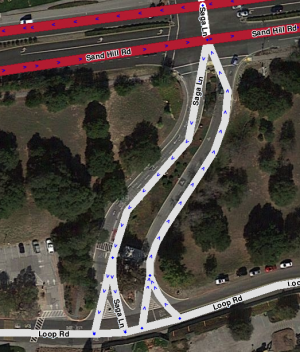

Common functional mistakes
A functional error introduces wrong or incomplete data or faulty routing. Functional errors must be addressed as soon as they are detected. If your incorrect edit was a functional mistake, the editor who discovered it has probably already taken steps to fix it.
It may be intimidating to see all the things that can be done wrong. Don't panic! This article includes a list of things that are generally safe and easy to edit for beginners.
Red roads
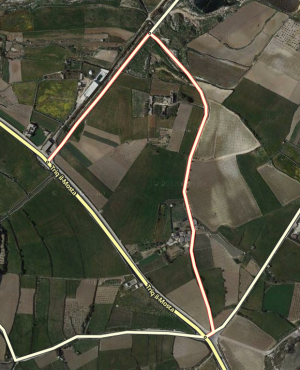
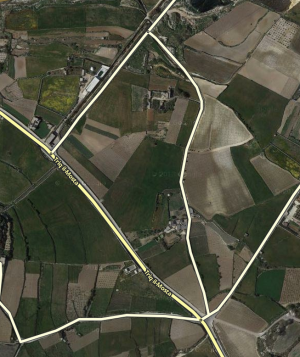
- For more details on this topic, see Creating and editing road segments.
Mistake: Roads that appear outlined in red in WME were published before all necessary parameters were set properly. Red roads created from the pave feature of the mobile app are useless for routing, while red roads created using WME are routable. In either case, their prominent display in the WME calls attention to incomplete edits.
Response: Do not automatically delete red roads! The road may be red because a user added a missing road using the pave feature, or because a local editor with first-hand knowledge created it in the editor but did not confirm its details. These roads may reflect construction that occurred since the satellite and/or street-view imagery was acquired.
If the red road appears to indicate a drivable road that will improve routing to adjacent destinations, complete it as necessary and verify turn restrictions. Try to preserve the creator's name out of respect for their having found the omission and attempting to remedy it.
If the red road is clearly spurious, or if finishing it would disrupt routing as in the common case of unnecessary parking-lot roads, private alleys or driveways, delete it.
Misplaced roundabouts
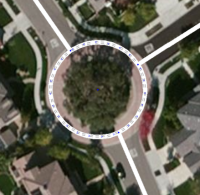
- For more details on this topic, see Roundabouts.
Mistake: The WME Roundabout tool creates an intersection that gives roundabout-specific routing instructions to drivers, such as "at the roundabout, take the third exit" (for roundabouts at complex intersections) or "turn left at the roundabout" (for roundabouts at simple perpendicular intersections). If those routing instructions could confuse drivers, the Roundabout tool should not be used. Roundabouts do not belong at cul-de-sacs or other dead ends, regardless of how round they are. Neither do they belong at traffic calming circles without roundabout signs, at decorative turns, or at circular entrance driveways. Depending on circumstances, they may be inappropriate for large traffic circles, especially those with street names of their own and stop signs or lights controlling access.
Response: If the satellite image leaves doubt, use Street View to verify that no signs suggestive of a roundabout are present. If it is a roundabout, ensure the layout matches the desired roundabout routing behavior, either orthogonal or odd-angle. If it is not a roundabout, delete it and replace or repair any associated connections.
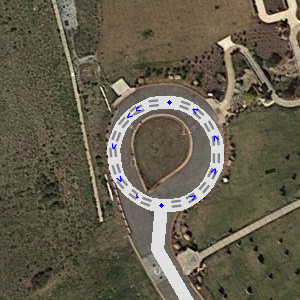
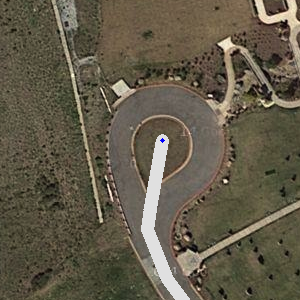
Overlapping segments
Mistake: Except in the cases of at-grade connectors and railroads, there should be only one segment routing traffic along any given street. Overlapping segments wreak havoc with the routing and house-numbering systems.
Sometimes editors create overlapping segments because they don't know how to modify the existing segment, or find it is locked above their editing rank. The correct approach is to seek help, not to add a new segment on top of an existing one.
Response: Identify the overlapping segment -- typically the one without house numbering and/or with improper connections to other nearby segments -- and delete it. Repair turn permissions.
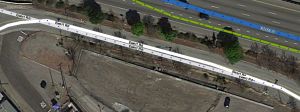
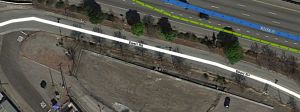
Disconnected/disjoint segments
Mistake: Just because segments appear to intersect doesn't mean they really do. A proper intersection will display all turn restrictions if any connecting segment is selected. A segment that only appears to connect will not only fail to route but will also confuse editors trying to understand the failure.
Response: If the intersection appears valid and the segment is correct, routable, and complies with conventions, connect the segment and set turn restrictions appropriately. If the intersection is not valid but the segments are correct, space them so it will be obvious to other editors that they do not connect, and consider locking them to be sure they stay that way. Otherwise delete the segment.
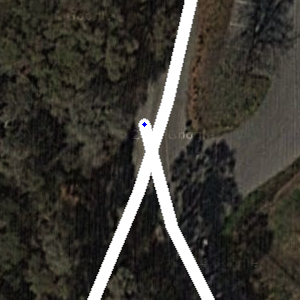
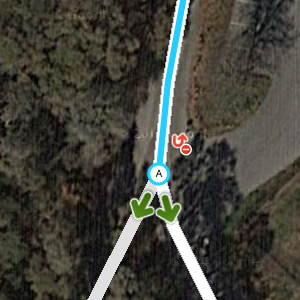
Failed editing due to locked segments
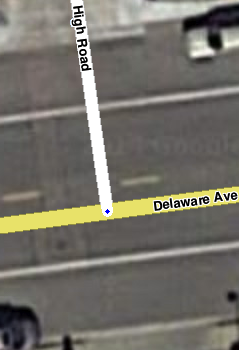
Mistake: It is impossible for entry-level editors to attach new segments to a road locked above their rank. If it is attempted, the result is disconnected/disjoint segments as described above. Worse, the new editor may assume that they did indeed correct the problem, and leave the area invisibly broken until someone else stumbles across it.
Response: At the very least, move the end of the disconnected segment away from the failed attachment area so that it is visually obvious to other editors that the road does not connect. You will cause no harm by doing so, as the routing connection is already broken. You are only making an invisible problem visible, which helps everyone.
Then, capture a permalink of the problem segment and contact an editor of the required rank to fix the connection. There are four typical ways to do this:
- Broadcast a request for help in the Waze Map Editor Chat. Be sure to specify the rank you need and the region involved. Not all editors monitor the chat, and of those that do, not all will have the necessary rank and editable area to help you. Before you call for help, adjust your editor view so that the problem segment lies in the middle of your window, as the helping editor may simply jump to your location via the chat-users list. Have the permalink handy to send if requested.
- Submit an "unlock/update request" to the Community Forums. This post describes the general procedure but is not country-specific. Many countries have their own unlock/update forums; it's important to post in the correct one and use the correct protocol! Include the permalink in your post.
- Send a Private Message (PM) via the forums to an active local editor of the necessary rank, such as an Area Manager or other local senior editor with whom you've established a connection. Include the permalink in your message.
- Send a PM to the editor whose name is marked as having last modified the locked segment. This does not always work but is worth trying especially if the first three approaches don't seem to be getting you anywhere. Include the permalink in your message.
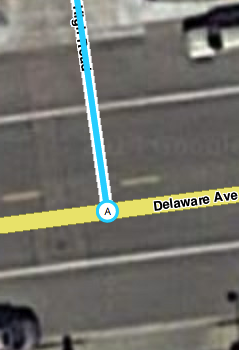
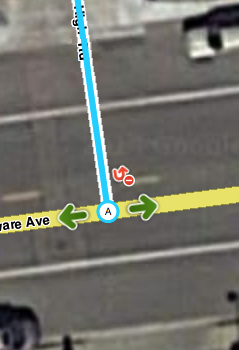
Corrupted turn restrictions
Mistake: Sometimes when modifying an intersection an editor will, through accident or lack of awareness, leave important turn restrictions red. This will prevent routing on the affected segments. In the worst cases significant roads may effectively be closed to Wazers, who are instead detoured through adjacent neighborhoods.
Response: Correct the turn restrictions as soon as possible.

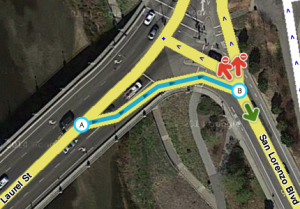
Excess or misaligned geometry nodes
- For more details on this topic, see Editing existing roads.
Mistake: Excess geometry nodes slow the display and make a segment harder to edit, while misaligned nodes affect display aesthetics and in extreme cases disrupt Waze's ability to determine what road a driver is on.
Response: Remove excess geometry nodes (using mouse-hover and the 'd' key) and correct misaligned nodes.
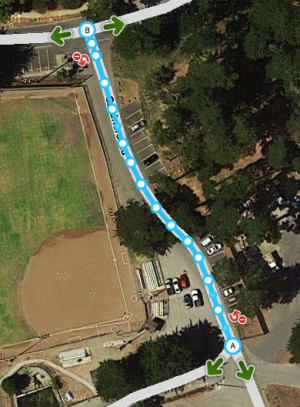
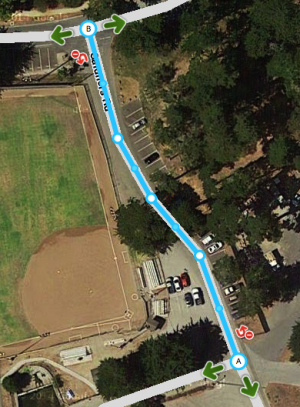
Misunderstanding the "Highway" road type
Mistake: It is counterintuitive, but in Waze, "highway" does not necessarily mean a road that carries a lot of traffic. It just means a road that carries more traffic than nearby alternatives. For example, a barely-maintained one-lane mountain road may be a "Minor Highway", and a two-lane street serving a small village a "Major Highway". Assessing a road by its significance relative to nearby alternatives is called "functional classification" or FC.
Such situations often baffle new editors to whom this application of the word "highway" seems absurd. As a result, some will attempt to "put it right" by lowering Highways to Streets or Primary Streets, unwittingly ruining the careful and methodical work that was required to set the road type according to national FC standards.
Response: Find the government FC map for the affected area and restore the Waze road classifications according to editing-community conventions. Consider locking the affected segments, especially if local convention recommends it.
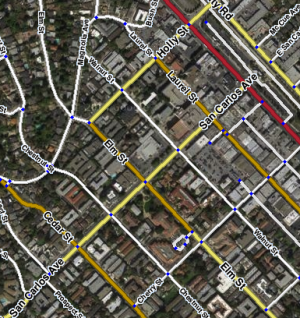
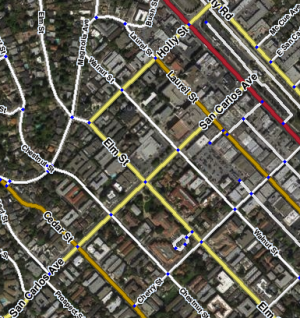
Unnecessary representation by divided one-way segments
Mistake: Just because a road is divided by a median strip in reality is not enough reason to represent it as divided in Waze! Dividing roads on the Waze map can cause much trouble and should not be attempted without care. Always check with the local Area Manager before dividing a road and follow best map-editing practice.
Response: Check with the local Area Manager or a Champ. Restoring roads to undivided status can cause as many headaches as dividing them in the first place. Do not automatically assume that a newly-divided road is incorrect, even if the road appears to have been divided poorly or by a novice editor.
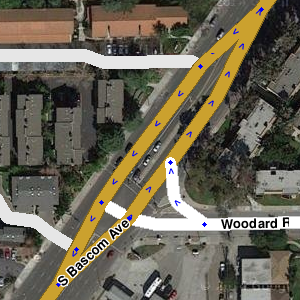
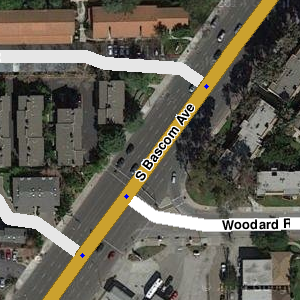
Walking Trails
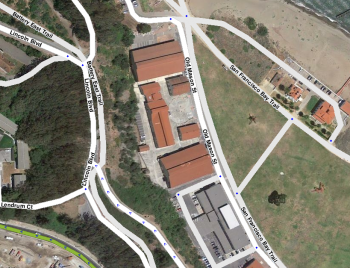
- For more details on the walking trail/pedestrian path road types, see pedestrian path.
Mistake: Because WME offers a "Walking Trail" road type, it may seem that Waze wants editors to map pedestrian and cycling paths in addition to normal roads for motor vehicles. This is not correct! Few circumstances call for mapping Walking Trails. They should be very rare and mapped by experts only.
| This information may need review as of WME v2.9-48. |
- Walking Trails are fully routable and can affect routing even when disconnected! Connected or not, the Walking Trail type should never be used where effects on local routing are not desired.
- The use of Waze while walking or cycling can damage Waze's speed and traffic database. Such uses should be discouraged. Editors should not map Walking Trails, or any other road type, for the sole purpose of encouraging non-driving Wazers.
- The presence of Walking Trails, even in remote areas where their routing properties may do less damage, encourages editors to add to the Trails or create new ones. If such paths are not drivable by at least a 4X4, they help perpetuate the mistaken belief that Waze is available to support pedestrians and cyclists.
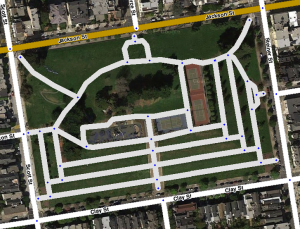
Response: Does the GPS Points layer leave no doubt that pedestrians and cyclists are Wazing heavily (albeit improperly) on the Walking Trail? And, is the Trail parallel to a drivable road, and close enough to it that, without the path being mapped, Waze might instead "snap" these improper Wazers to the road? If so, convert the Trail to the Pedestrian Boardwalk type.
Does the Walking Trail appear to indicate a road intended and maintained for common use by street-legal motor vehicles? Then change the road type to an appropriate drivable road type, and if the road is available for driving only to a handful of officially-authorized personnel, such as emergency or fire crews, be sure it is disconnected from the road network.
Could it help orient drivers to see the Walking Trail displayed? For example, where a major neighborhood path, such as a Rails-to-Trails path, crosses a road? Then change its type to Pedestrian Boardwalk or Stairway, as appropriate. Such uses are best kept to a minimum; remember, their purpose is to orient drivers, not to encourage pedestrians and cyclists to use Waze!
If none of the above apply, evaluate the purpose of the Walking Trail. Is it in place only to support and encourage non-driving Wazers? Is there no chance a driver might find it useful for orientation while driving, or for reaching a destination? In such cases the Walking Trail is likely causing more harm than good and should be removed.
Even complex work by an active editor, if it is noncompliant, will still need to be modified or removed. Before proceeding in such cases, however, please attempt contact with the segments' creator and include a link to this article. Common courtesy and community spirit require that he or she be alerted and given a generous opportunity to respond. If there is disagreement, contact an area manager or local Champ.
Access roads that distort routing
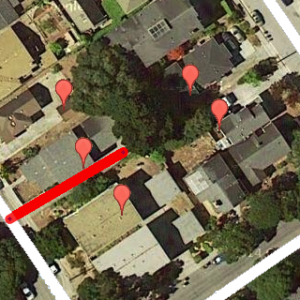
- For more details on private access roads and driveways, see Driveways.
Mistake: New editors often believe that if you can drive it, you can map it, and commonly add parking-lot roads, driveways, and private alleys because they are there. Such roads can distort rather than enhance routing! Once it has a destination position, Waze attempts to route drivers on whatever road will get them closest to the destination coordinates. This means some roads can have unintended routing consequences. For example, if you add a private road to your house as in the figure, Wazers visiting your neighbors will find themselves routed up your driveway.
Unnecessary roads can also cause routing distortions when departing a destination. This results from Waze's attempt to "snap" the driver to the nearest available road before determining a route. If you add a private alley that connects two streets through a warehouse district, for example, a delivery person nearer to the alley than the street may be snapped incorrectly to the alley and given an impossible route to his next destination.
In general, you should map roads because they are necessary for routing and not simply because they are there.
Response: If the road does not comply with the driveway guidelines, consider deleting it. If it appears to comply but causes routing issues that cannot be improved by editing the driveway or adding additional compliant road segments, consider deleting it.
Unnecessary at-grade connectors
- For more details on this topic, see At-grade connectors.
Mistake: At-grade connectors are generally not necessary unless an upcoming turn requires uncommonly early action by the driver. Unnecessary at-grade connectors are more trouble to analyze and maintain, and their close proximity to the through road from which they depart can lead Waze to snap drivers to the wrong road. Asking for a route while snapped to the wrong road, for example while waiting at a stoplight too near an at-grade connector, will result in incorrect routing.
Response: Delete the unnecessary at-grade connector as well as any newly-unnecessary junction nodes that result, and modify turn restrictions to account for the new routing.
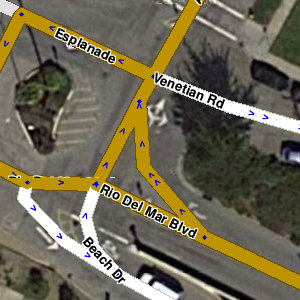
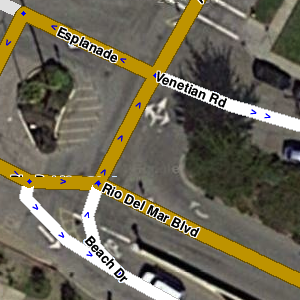
Misuse of the Ramp road type
Mistake: One seldom needs the Ramp road type unless editing around controlled-access highways or freeways. Entry-level editors often use Ramps in places they don't belong, particularly for at-grade connectors (AGC). The Ramp guidelines provide details on appropriate use of ramps.
Response: Change to the correct road type and rework if necessary, or delete if unnecessary. In the case of an AGC, check if the ramp is an allowed exception before changing it to another road type in accordance with the AGC road-type guidelines. Verify turn restrictions.
Commonly misunderstood conventions
Misunderstood conventions do not necessarily involve wrong data or faulty routing, but violate editing conventions agreed upon by the local Waze editing community. The damage done by a misunderstood convention is primarily by example; other editors will interpret the error as a model for what they should do, and the mistake will proliferate.
If you've been approached regarding misunderstood conventions, you may have been given the opportunity to correct or delete your work. Please do so! It may be the least enjoyable thing you will do in Waze, but if you don't do it, someone else eventually will, and in the meantime the incorrect example may influence other new editors.
It may be intimidating to see all the things that can be done wrong. Don't panic! This article includes a list of things that are generally safe and easy to edit for beginners.
Excessive use of Parking-Lot Roads
| As of October 2018[update], guidance changed to recommend more detailed mapping of Parking Lot roads, in those lots which should be mapped. There is no priority to adapt existing lots to the new standards unless working on or near the lot for other reasons or there is guidance from a senior editor to pursue it. |
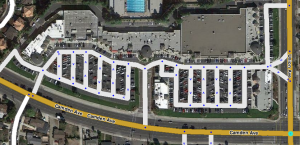
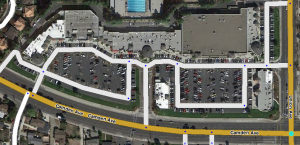
- For more details on this topic, see Parking Lots.
Misunderstood convention: While mapping every lane in a parking lot does not cause functional problems, it does create a busy appearance in the client display. Until October 2018, the Waze editing community followed a convention of only mapping the minimum number of parking-lot roads necessary to ensure proper routing to and from destinations. It was thought that in most cases only a few peripheral and key parking-lot roads were necessary, and it was known that in some cases adding parking-lot roads would disrupt local routing rather than improve it. These concerns remain valid; however, judicious mapping of internal parking-lot roads is now thought to benefit routing in some cases. Please see the details linked above.
Response: Please review the details linked above before removing parking-lot roads thought to be unnecessary or excessive. Remember that parking-lot roads absorb slowdown detection, so be sure not to delete lanes that "protect" adjacent thoroughfares from spurious heavy-traffic warnings.
Misuse of Area Places
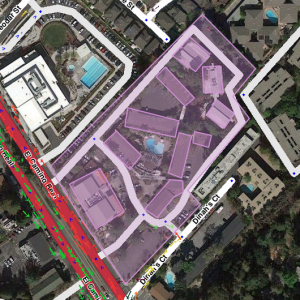
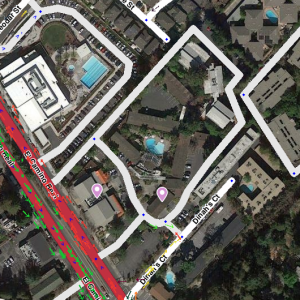
- For more details on this topic, see Places.
Misunderstood convention: Area Places (formerly known as Landmarks) appear on the client display as colored polygons, helping to orient the driver by indicating distinctive structures or open space. Current convention holds that Area Places should always be associated with "visual significance", locations that stand out from their surroundings because of their appearance or their size (an exception is made for locations considered potentially critical to drivers, such as gas stations, or hospital, police or other emergency services).
As a result, use of an Area Place to mark a location that does not stand out from its surroundings in any way detracts from the ability of other Area Places to serve their primary function. Such a location may not satisfy local editing conventions for Area Places and may wind up reworked by another editor. To make the Area-or-Point decision more objective, a large table specifies many Place categories that should always be marked with Point Places.
Like all Places, Area Places should be named. Without a name, an Area Place cannot be used as a routing destination and appears on the user's client display only as an unidentified colored polygon. Area Places without names are more likely to be modified or removed.
Controversy surrounds the Area Place. Some senior editors disagree with the current Place guidelines and recommend that editors be allowed greater flexibility in creating Area Places large and small; others argue that Point Places provide navigation and routing capabilities identical to those of Area Places and ask that Area Places be reserved only for critical or visually-significant locations. However things turn out, the safest approach for now is to abide by the current guidelines.
Response: First, ensure you are familiar with local standards for Area Places. Some regions may depart from global Area Place guidance. See your state page for details, or check with an Area or State Manager.
If an Area Place does not satisfy global or local guidelines for Area Places, but it would be correct and compliant as a Point Place, convert it to a Point Place and adjust its location for best routing. If it would not be correct or compliant even as a Point Place, remove it.
Always, before removing or modifying an Area Place, take a moment to consider how much effort went into its creation. Do not modify a complex Area Place, even a non-compliant one, without first sending the author a link to this article via PM and allowing him or her considerable time, perhaps several weeks, to modify or remove it. In the rare case of disagreement, contact an area manager or local Champ.
Misuse of the Parking-Lot Area Place
- For more details on this topic, see Parking Lot Area Place.
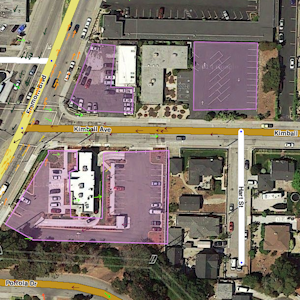
Use of the Parking-Lot Area Place.
Misunderstood convention: The Waze Map Editor gives easy and prominent access to the Parking-Lot Area Place directly from the create menu. There are parking lot places that do not meet the standards of the community in the editor.
Response: The Waze editing community only uses the Parking-Lot Area Place for off-street parking. For detailed information about mapping parking lots please see Parking Lot Area Place
Some Parking Lots have been imported with their street address as their Primary Name. This should not be so. These were imported from a 3rd party partner using a staff automated account. If the parking lot does not have a name please move the street address to the address fields and leave the Primary Name blank. Do not use the address as the primary name.
As with Area Places in general, before removing or modifying a Parking-Lot Area Place, take a moment to consider how much effort went into its creation. Do not significantly alter a complex Parking Lot, even a non-compliant one, without first sending the author a link to this article via PM and allowing him or her considerable time, perhaps several weeks, to modify or remove it. In the rare case of disagreement, contact an area manager or local Champ.
Closing URs without proper consideration
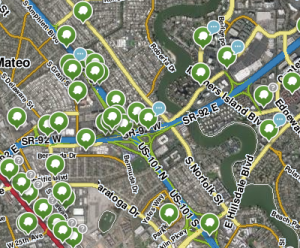
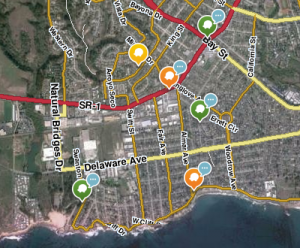
- For more details on this topic, see Update Requests.
Misunderstood convention: Waze users file Update Requests (URs) to alert the editing community of problems they experienced. Drivers rarely have time to enter an adequate description when they submit a UR. They depend on the editing community to open a conversation so they can explain more fully what happened. Handling URs follows a careful process that provides drivers with an opportunity to clarify their report, and editors with enough time to work the report once they begin.
Closing a UR will permanently end the associated conversation and will alert everyone involved in it. Following UR etiquette provides all parties an opportunity to reach closure before that happens. Breaches of etiquette include the following:
- Closing a UR with an empty conversation. Even very old URs deserve a comment. If you are closing a UR you reported, add a comment anyway as a courtesy to other editors. Note: URs with an excessively abusive or completely nonsensical opening description may be closed without comment.
- Closing a UR without offering the reporter an adequate chance to respond to an initial query. Wait at least 7 days after the initial query (period may be shorter or longer by state or region) before closing the report. A followup request before closure is strongly encouraged. Note: some URs do not appear to require more information, but the reporter has been given an option to clarify anyway. The minimum waiting period and followup request are less critical for these.
- Closing a UR whose reporter has responded to an inquiry by another editor. Once the reporter responds to an editor's inquiry, that editor determines how to proceed. While other editors are welcome to contribute to the conversation, it is important they not close the UR even if the conversation appears to have lapsed or if no solution is evident. This is because the original editor may be pursuing the problem behind the scenes. If the UR conversation appears stale, it may be renewed with a note like "Any progress?" or "Time to close as not identified?". If the original editor does not respond within 7 days (may be shorter or longer by state or region), or explicitly waives further interest in the UR, you may take charge. Note: the concept of a single "managing editor" for URs is often relaxed during a MapRaid event.
- Closing a UR that the first responding editor may consider proprietary. Some editors feel that being the first to respond to a UR establishes them as managing it. This may be especially true in areas with few URs, where editors welcome the opportunity to work them. Unless the first responder has explicitly communicated that the UR is open to others, such as in a personal communication or with an "open to any editor" comment in the initial response, it is best to treat closing the UR as the first responder's responsibility, but some states or regions may not support first-editor ownership of a UR by default, and instead leave URs open to any editor to work or even close unless advised otherwise. Even if the UR appears dead, rather than close the UR, ask if there is progress and wait 7 days before taking action (period may be shorter or longer by state or region). Note: proprietary interests in URs are typically suspended during a MapRaid event.
Response: Once closed, a UR will remain accessible for several days. A skilled editor who catches the closure in time and moves quickly may be able to work a closed UR before it disappears. If a dialogue can be established with the reporter, it can be continued using the emailed links to the UR conversation even after the UR has disappeared from the map.
What should I edit, then?
Your energy is best focused on regions you know, but if you live and work in a heavily-populated area, your local neighborhoods may have been edited and re-edited many times. There may be little left to do aside from removing excess geometry nodes, correcting minor misalignments, and verifying turn restrictions.
Consider editing less-traveled locations you may have visited recently. Many non-industrial and rural communities have seen little attention since the original base-map import. Such regions often abound with misnamed roads, dirt roads misclassified as streets, improper turn restrictions and street directionality, roads shown as through that do not go through, and so on. Finding good information to correct these issues may take some work, especially in more remote areas, but it is a terrific contribution.
If you do choose to focus on a heavily-edited area, be aware that many have come before you. Things that don't seem right at first may have resulted from days or even weeks of careful adjustment. Exercise caution before modifying other editors' work.
Constructive work for new editors
- Verify road-name spelling and capitalization by checking against local government GIS as well as signage viewed in street-view imagery, and ensure name consistency within city boundaries.
- Verify that street-type suffix abbreviations (e.g. for Road, Drive, Avenue, etc.) are used and comply with abbreviation standards.
- Verify that street-type prefixes in cases such as "Avenue of the Flags" (and in the US, particularly Spanish street-type prefixes such as Calle, Paseo, Avenida, etc.) are not abbreviated unless that is local custom.
- Verify road directionality, particularly one-way roads that Waze may show as two-way.
- Verify turn restrictions, including timed turn restrictions.
- Correct streets shown as through on the Waze map but that are blocked in reality.
- Add recently-constructed roads not yet shown on the maps, or shown incorrectly due to obsolete satellite and street-view imagery.
- Correct road alignment errors and remove excess geometry nodes.
- Contribute suggestions to User-Request conversations already opened by other editors, particularly if you have local knowledge that could help resolve the issue.
- Alert area managers and/or senior editors to problems.
- Add or update name, city, and address data for existing Point or Area Places.
- Correct categories for existing Point or Area Places; in particular, when Waze rolled out Places, existing hotels were often assigned the category of "Hostel" instead of "Hotel".
- Add Point Places.
Risky work for new editors
- Adding non-drivable roads such as walking trails, railroads, runways and taxiways, etc. (they may not sound risky, but because of the way Waze implements these they are surprisingly likely to influence routing in the immediate area).
- Upgrading or downgrading road types among Street, Primary Street, Minor Highway, and Major Highway (risk of ruining meticulously-done FC settings).
- Adding parking-lot roads (risk of overdoing it, of disrupting routing to nearby destinations, of leaving behind corrupted turn restrictions, or of failing to join the roads to adjacent locked segments).
- Adjusting major intersections, ramps, or highways (highly likely to encounter locked segments, but even if not, risk of disrupting heavily-traveled areas).
- Dividing or un-dividing roads.
- Working and closing user-submitted Update Requests (requires extensive familiarity with UR etiquette and with common problems encountered by Wazers).
- Editing inside Private Installations (tracking the routing penalties requires great care).
- Adding or modifying roundabouts.
- Adding Area Places of any kind, including those for natural features as well as those for properties.
Further exploration
The Waze wiki
The Waze wiki offers a wealth of detail on all aspects of map editing. The following pages are good places to start. Be sure also to find and read the editing guidelines specific to your country.
- Map Editing Quick-start Guide
- Best map editing practice
- Map Editing Tips and Hints
- Waze Map Editor
- Editing manual
- Creating and editing road segments
- Road types
- Road names
The Waze forum
All editors are encouraged to ask questions and access current conversations on the Waze forum. Start by reading this post.
Third-party scripts
As you become more comfortable with the WME, you may wish to explore optional browser modifications, or scripts, developed by volunteers from the Waze editing community. You can edit the Waze map very successfully without ever adding a script to your browser! But once you understand WME's basic operation and can recognize and avoid the incorrect edits described in this article, you may find scripts can help you align junctions, validate your work, and detect potential problems more quickly.
When you are ready to explore scripts, visit Community Plugins, Extensions and Tools. In particular, you may find WME Color Highlights (WMECH), WME Junction Angle Info, WME Toolbox, and WME Validator helpful for identifying problems, recommending solutions, and directing you to relevant documentation.